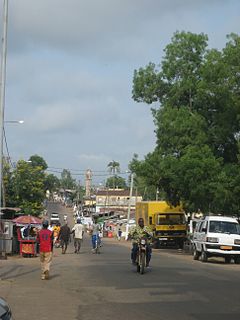
The Central African Republic (CAR) is classified as one of the world's least developed countries, with an estimated annual per capita income of $547 PPP (2014).

The economy of Togo has struggled greatly. The International Monetary Fund (IMF) ranks it as the tenth poorest country in the world, with development undercut by political instability, lowered commodity prices, and external debts. While industry and services play a role, the economy is dependent on subsistence agriculture, with industrialization and regional banking suffering major setbacks.

Millets (/ˈmɪlɪts/) are a group of highly variable small-seeded grasses, widely grown around the world as cereal crops or grains for fodder and human food.

Mineiros is a municipality in the southwest of the state of Goiás, Brazil. Mineiros is the westernmost city in Goiás and a great producer of cattle, soybeans, and corn, and has a population of 52,964 inhabitants.

Kara is a city in northern Togo, situated in Kara Region, 413 km north of the capital Lomé. Kara is the capital of the Kara region and, according to the 2010 census, had a population of 94,878. The Kara River flows through the city and is its main resource of water. Originally known as Lama-Kara, the city developed from the village of this name that still exists into an administrative centre. Étienne Eyadéma was born in the nearby village of Piya.

Sorghum bicolor, commonly called sorghum and also known as great millet, durra, jowari, or milo, is a grass species cultivated for its grain, which is used for food for humans, animal feed, and ethanol production. Sorghum originated in Africa, and is now cultivated widely in tropical and subtropical regions. Sorghum is the world's fifth-most important cereal crop after rice, wheat, maize, and barley. S. bicolor is typically an annual, but some cultivars are perennial. It grows in clumps that may reach over 4 m high. The grain is small, ranging from 2 to 4 mm in diameter. Sweet sorghums are sorghum cultivars that are primarily grown for forage, syrup production, and ethanol; they are taller than those grown for grain.

Senegal's economy is mostly driven by agriculture, fisheries, mining, construction and tourism. Most of Senegal lies within the drought-prone Sahel region, with irregular rainfall and generally poor soils. With only about 5 percent of the land irrigated, Senegal continues to rely on rain-fed agriculture, which occupies about 75 percent of the workforce. Despite a relatively wide variety of agricultural production, the majority of farmers produce for subsistence needs. Production is subject to drought and threats of pests such as locusts, birds, fruit flies, and white flies. Millet, rice, corn, and sorghum are the primary food crops grown in Senegal.

Commercial sorghum is the cultivation and commercial exploitation of species of grasses within the genus Sorghum. These plants are used for grain, fibre and fodder. The plants are cultivated in warmer climates worldwide. Commercial Sorghum species are native to tropical and subtropical regions of Africa and Asia.

In 2006 approximately 80% of Chad's labor force was employed in the agricultural sector. This sector of the economy accounted for almost half of the GDP. With the exception of cotton production, some small-scale sugar cane production, and a portion of the peanut crop, Chad's agriculture consisted of subsistence food production. The types of crops that were grown and the locations of herds were determined by considerable variations in Chad's climate.

Agriculture in Israel is a highly developed industry. Israel is a major exporter of fresh produce and a world-leader in agricultural technologies despite the fact that the geography of the country is not naturally conducive to agriculture. More than half of the land area is desert, and the climate and lack of water resources do not favor farming. Only 20% of the land area is naturally arable. In 2008 agriculture represented 2.5% of total GDP and 3.6% of exports. While farmworkers made up only 3.7% of the work force, Israel produced 95% of its own food requirements, supplementing this with imports of grain, oilseeds, meat, coffee, cocoa and sugar.

Agriculture employs the majority of Madagascar's population. Mainly involving smallholders, agriculture has seen different levels of state organisation, shifting from state control to a liberalized sector.

Although Burkina Faso is not self-sufficient in food, agriculture in Burkina Faso has tremendous potential. It employs the vast majority of the work force and accounted for an estimated 31 percent of Gross Domestic Product in 2004. However, only an estimated 13 percent of the total land area is under annual or perennial crops. Government attempts to modernize the agricultural sector have met with some success, especially with cotton, whose export accounted for 51 percent of total exports in 2004. In 2004, about 85 percent of the 210,000 tons of cotton produced was exported. The resistance to improvement has been due mostly to the insufficient water supply and poor soil. Although total cereal production rose from 1,547,000 tons in 1990 to 3,063,000 tons in 2004, imports are needed to meet demand.
About 90 percent of the population(Burundi) depends on agriculture for a living. Most agriculture consists of subsistence farming, with only about 15 percent of the total production marketed. An estimated 1,351,000 hectares (3,338,000 acres), or about 52.6 percent of the total land area, is arable or under permanent crops; about 5.5 percent of cropland is irrigated. The average farm family plot is 0.8 hectares. Agriculture accounted for 51 percent of the GDP in 2004. Coffee and tea exports comprise the majority of foreign earnings; coffee alone accounted for 39 percent of exports of goods in 2004. Agricultural exports accounted for 48 percent of exports in 2004. Principal crops for local consumption are manioc, beans, bananas, sweet potatoes, corn, and sorghum. Production in 2004 included bananas, 1,600,000 tons, mostly for wine; manioc, 710,000 tons; sweet potatoes, 834,000 tons; beans, 220,000 tons; sorghum, 74,000 tons; corn, 123,000 tons; peanuts, 8,800 tons; and yams, 9,900 tons.
Agriculture in Cameroon is an industry that has plenty of potential.

In the early 1990s, agriculture and livestock raising were the main sources of livelihood in Sudan for about 61 percent of the working population. Approximately one-third of the total area of Sudan is suitable for agricultural development and heavier rainfall in the south permits both agriculture and herding by nomadic tribes.

Throughout its history, agriculture in Paraguay has been the mainstay of the economy. This trend has continued today and in the late 1980s the agricultural sector generally accounted for 48 percent of the nation's employment, 23 percent of GDP, and 98 percent of export earnings. The sector comprised a strong food and cash crop base, a large livestock subsector including cattle ranching and beef production, and a vibrant timber industry.

Agriculture in the Democratic Republic of the Congo is an industry in the country of the Democratic Republic of the Congo that has plenty of potential.
Mozambique has a variety of regional cropping patterns; agro-climatic zones range from arid and semi-aCFVrid DDXCD(mostly in the south and south-west) to the sub-humid zones to the humid highlands. The most fertile areas are in the northern and central provinces, which have high agro-ecological potential and generally produce agricultural surpluses. Southern provinces have poorer soils and scarce rainfall, and are subject to recurrent droughts and floods.
Sorghum comes from the Latin name “Syrucum (granum)” which means “grain of Syria” however it originated in eastern Africa. Sorghum is an important species of the grass family, Paceae, and is considered the world’s fifth most important cereal crop. There are many diverse and wild types of Sorghum, however there are seven basic races, the most common in Asia are Durra and Sballu. Sorghum is an important staple crop for more than 500 million people in sub-Saharan Africa and South Asia, including many people in Nepal. Sorghum is grown on more than 48 ha area around the world. In statistics collected from 1992-1994 about general millet, Nepal had an area of 0.21 million ha, with a yield rate of 1.14 (t/ha), and produced around 0.24 million tons of Sorghum. The entirety of the crop is highly valued, both the grain and the stem are very useful. Sorghum can be cooked in many different ways for food with a high nutritional content, among many other uses. Overall Sorghum is a very important crop worldwide.
















